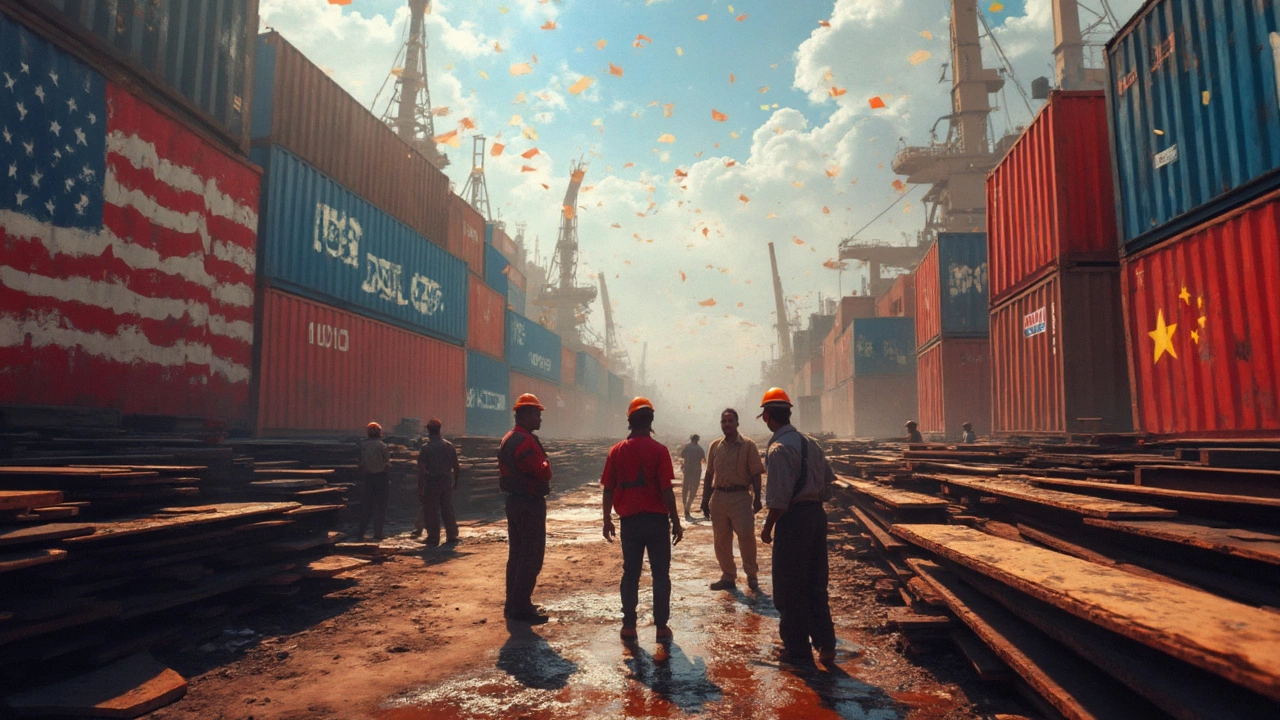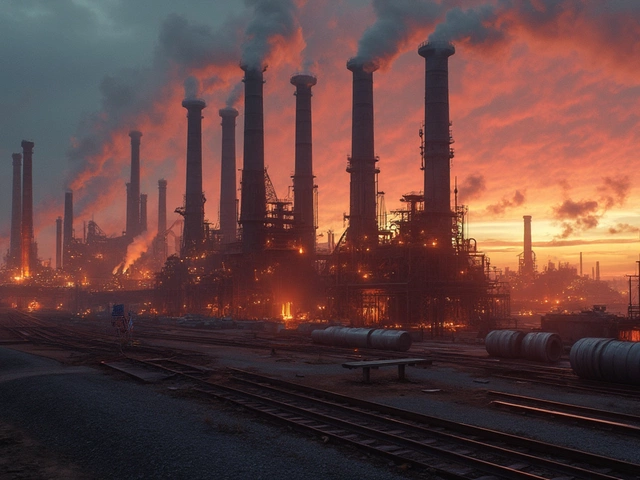Think China’s snapping up boatloads of American steel? It’s not that simple. If you run a steel plant or work anywhere near the industry, you’ve probably heard all sorts of takes around the lunch table. Some folks picture endless container ships packed with U.S. steel heading for Shanghai. In reality, the flow is almost all in the other direction.
China is the world’s biggest steel producer by a huge margin. They don’t just make steel for their own skyscrapers and high-speed trains—they make so much that they supply half the world. So, when US steel lands in China, it’s usually for something niche: high-quality grades, specialized alloys, or very specific applications that Chinese factories can’t easily replicate. But in pure volume? China buys way less American steel than most people think.
If you want to know what really happens to your beams, coils, or sheets, you need to peek inside how trade works, all the policy hiccups, and who actually controls the flow. This stuff matters big time for plant owners. The difference between a fat contract and a mothballed mill can hang on a tiny change in international demand.
- China’s Demand for Steel: What’s It Really Like?
- Does the US Ship Steel to China?
- Tariffs, Politics, and Trade Barriers
- How Steel Plants Can Navigate International Markets
China’s Demand for Steel: What’s It Really Like?
When people talk about steel, China’s the elephant in the room. They don't just use steel—they produce so much, it almost feels unfair to everyone else. In 2023, China made roughly 1,000 million metric tons of steel. That’s more than the next 10 countries combined. How can one country need that much? Turns out, building cities, new rail lines, and giant ports takes mountains of the stuff.
Unlike the US, where older infrastructure still limps along, China’s always got cranes in the air and new factories popping up. Every apartment block, subway, and bridge devours steel by the ton. Still, it’s not a free-for-all—they want cheaper steel for basic construction, but for special uses (like automotive, aerospace, or energy), local suppliers don’t always fit the bill.
Despite the size of China’s market, they mostly fill their own needs. Imports are a smaller piece of the puzzle, often riding on quality or specialty. Here’s how the numbers stack up for 2023:
| Country | Steel Produced (Million MT) | Steel Imported (Million MT) | Main Uses |
|---|---|---|---|
| China | 1,000 | ~70 | Construction, Manufacturing, Export Goods |
| US | 80 | ~25 | Automotive, Construction |
The China steel market cares about speed, price, and capability. If a local mill can do the job, they won’t call overseas. However, if they’re missing a high-quality product that no one nearby makes, like precise automotive steel, they’ll scan the market—even if that means paying a premium to import it.
If you’re eyeing China for steel deals, remember: you’re up against the home team in their own stadium. Competition is tight, and government rules make it even trickier to break in. But big demand does open a door if you’ve got something unique to offer.
Does the US Ship Steel to China?
If you ask around a steel plant, most folks will tell you it’s China flooding the world with cheap steel, not the other way around. They’re mostly right. China is by far the top steel maker and exporter, and the US is actually a net steel importer, not exporter. Very little American steel finds its way to China.
Let’s get specific. US steel exports to China are tiny—less than 1% of total US exported steel ends up there in most years. To put numbers on it, in 2023, the US exported about 7.2 million metric tons of steel, but only around 45,000 tons of that went to China. Most US steel heads to Canada, Mexico, and a bit to the European Union. China barely registers as a destination.
If China does buy American steel, it’s almost always for stuff that’s tough to get locally. Think unusual alloys, unique grades, or military-grade stuff. Large bulk orders? Forget it. China’s got its own massive mills for those. Once in a while, a specialty order slips through for an automaker or an electronics plant in China, but it’s the exception, not the rule.
Here’s what the US exported to top countries in 2023, just to give a sense of scale:
| Country | US Steel Exported (tons) |
|---|---|
| Canada | 3,950,000 |
| Mexico | 2,500,000 |
| China | 45,000 |
| EU (28) | 250,000 |
So if you’re running a mill or thinking about breaking into the Chinese market, don’t expect big volume. The market just isn’t there for plain old rolled or structural steel. If you want in, it’s all about high-tech or unique stuff that China can’t turn out by the megaton.
The short answer: Yes, the US does ship steel to China, but it’s a blink-and-you’ll-miss-it trickle. You’ll have more luck focusing on Canada, Mexico, or looking for specialty projects in China that call for your best work.

Tariffs, Politics, and Trade Barriers
Nothing shapes the steel trade between the US and China more than politics and tariffs. Since 2018, this has been front-page news. When the US government, under the Trump administration, slapped a steep 25% tariff on imported steel using Section 232 on national security grounds, China shot back with their own barriers. American steel suddenly got a lot more expensive for Chinese buyers, even if they wanted it.
By the numbers, steel exports from the US to China have always been a tiny fraction of total steel trade. US Census Bureau figures show the US shipped less than 1% of its exported steel to China in recent years—sometimes even less than that. That’s not just because of cost. It’s red tape, inspections, and outright bans. A Chinese plant manager might love the specs on American high-strength steel, but government limits can squash the deal before it starts.
Here’s what’s made it tough for American steel plants to find Chinese buyers:
- High tariffs: Both countries slapped steep tariffs on each other’s steel as part of a wider trade battle, and most of those are still in place in 2025.
- Quality certifications: China puts tough requirements on what steel it will buy from outside, demanding lots of paperwork and certifications.
- Political uncertainty: One executive decision can change the rules overnight, so buyers and sellers both get nervous about long-term contracts.
- Retaliatory actions: China sometimes adds extra barriers if political talks go sideways, using steel as a bargaining chip.
This climate is why you don’t see many American steel plants chasing Chinese contracts anymore. The paperwork alone is a headache. Add in unpredictable costs, and most US mills turn their sights to friendlier, more predictable markets. If you’re running a plant, it pays to factor in not just what Chinese companies want, but what the two governments might throw onto the playing field next week.
How Steel Plants Can Navigate International Markets
Jumping into international steel trade isn’t just about calling up a foreign buyer. It’s a maze—tariffs, quality demands, and currency swings can mess up even the smartest plan. Here’s how plant owners can actually make it work.
First up, know your product. China, for example, is picky when it comes to import standards. They need certification for grades, traceability for raw materials, and proof of exact specs. Getting these docs in order is non-negotiable—otherwise, your shipment might sit in customs limbo for months. And since the US mostly exports niche steel—like electrical steel or top-grade pipes—this niche focus helps plants stand out.
Trade rules are more than background noise. Since 2018, the US and China have locked horns over tariffs. Right now, US steel faces steep duties going into China—a 25% tariff dropped in 2018 alone, with more at times. That’s why only certain steel types, ones China can’t make cheap, still squeeze through. Many American plants work with middlemen in countries like Vietnam or South Korea who process US steel and re-export it to China under different rules. It’s a workaround, but it’s also a legal and logistics headache.
If you want to see where business stands today, check out the numbers. Here’s a quick look at recent US steel exports to China versus elsewhere:
| Year | US Steel Exports to China (million metric tons) | Total US Steel Exports (million metric tons) |
|---|---|---|
| 2021 | 0.09 | 7.0 |
| 2022 | 0.07 | 7.2 |
| 2023 | 0.08 | 7.5 |
Barely 1% of all US steel exports wind up in China. If your plant is chasing serious action, you’ll want to look beyond China to other Asia-Pacific buyers—like Thailand, Malaysia, or even Japan—who buy bigger quantities and sometimes have friendlier trade terms.
- Focus on niche products where US plants have an edge, like high-strength alloys or electrical steel.
- Double-check all documentation before shipping—missing the mark can mean huge delays or rejected shipments.
- Keep an eye on trade policy changes. Even a single tariff announcement can swing profitability by a mile.
- Build strong relationships with trusted logistics partners, especially if indirect routes are needed.
- Explore government support programs, like the US Commerce Department’s international trade administration—they help with everything from legal paperwork to matchmaking with buyers abroad.
Growing in the global market is tough, but it’s not impossible. Find your niche, keep flexible, and never lose sight of the steel quality that sets you apart. My own kids, Cillian and Rhea, always ask why I focus so much on paperwork and trade news—it’s because that’s where deals sink or swim.






Write a comment